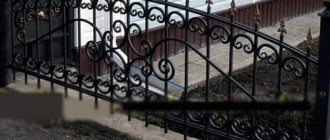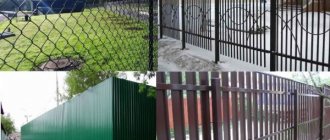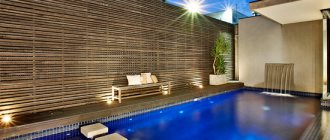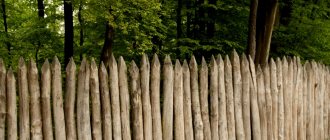What are wrought iron fences
Forged fences are metal fences with elements of artistic forging. The latter include peaks, balusters, leaves and many other ornamental elements. Usually they are attached to a base - an iron sheet or rods. The result is a simple geometric pattern or artistic composition - for example, a fence in the form of flowers and a plant pattern.
Such structures perfectly fulfill their primary function - protecting against the penetration of strangers. They also have decorative functions: they decorate the landscape design, attract attention and help to successfully complement the facade and design of the site.
Types of forged fences
With polycarbonate . They are two-layer: the first, main layer, is made of polycarbonate. This is a translucent material that transmits sunlight well. It is colorless or colored - in the latter case, the rays of the sun, passing through the material, create a beautiful play of light. The second layer is a frame made of metal rods with welded elements of artistic forging. The structures look light due to the almost weightless base. For example, a wrought-iron fence with Saintpaulia polycarbonate looks great in the evening, during sunset.
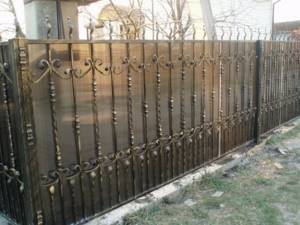
With iron sheet . A flat iron sheet is used as a base. It is often painted to match the color of the artistic forging elements used to create the ornament. Such gates do not allow sunlight to pass through, therefore protecting the area from the view of strangers. In addition, they can withstand greater loads compared to polycarbonate: the iron sheet is deformed upon impact, but will not crack.
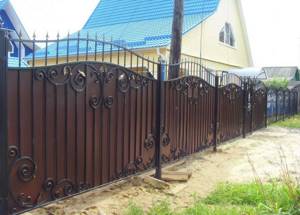
With a professional sheet . Profiled sheet is a corrugated iron sheet. It is also used as the first layer, painted mainly in brown, green or red. Due to the corrugations, the corrugated sheet is stronger than ordinary iron sheet and polycarbonate. It is able to withstand significant mechanical and wind loads. At the same time, it looks quite stylish, especially if you choose a good combination of colors - such as in a forged fence with peaks and “Mulatto” monograms.

With brick . In this design, elements of artistic forging occupy only a small part. The base of the fence is made of stone, brick, cement or blocks. And metal decorations - artistic forging - usually decorate the top of the fence. They are small frames filled with elements of artistic forging. This solution looks especially good outside the city; for example, a wrought-iron fence “Lanalia” will suit a three-story cottage with a large garden plot.

Welded . Such structures are often used on large areas. They do not have a base - instead there are rods located at a distance of 10-15 centimeters from each other and decorated with decorative elements. Through the fences you can see everything that is happening on the site, so they are used less often compared to other types of fences. But they look attractive and do not limit the landscape design - for example, a fence with metal curls will look ideal by the sea, because it resembles sea waves.
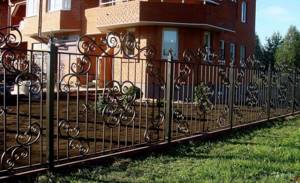
Pros and cons of fencing
A wrought iron fence with wooden inserts has advantages and disadvantages. Let's look at the list in detail.
Advantages of the forged part of the structure:
- Durability, reliability. Such a fence is strong and impregnable.
- Easy to care for. There is no need to tint or change anything.
- Metal and forging embody any design wishes. Graceful curls or entire scenes - the metal will be transformed at the request of the blacksmith.
- If we are talking about traditional forged elements and patterns, it will not take much time to manufacture metal sections. Manufacturing according to individual drawings will require much more time.
Disadvantages of the forged part:
- High price.
- Corrosion. You will have to periodically treat the fence to maintain its appearance and increase its service life.
- Wood is a durable, beautiful and environmentally friendly material. Wood complements metal, makes the fence impregnable, protects from views, and does not allow road dust to enter the area.
Adding metal?
Definitely Most likely not
Advantages of wooden structural elements:
- Dense wood paneling will hide the area from prying eyes, making the structure durable and impregnable.
- Wooden inserts affect the cost of the structure. This option among wrought iron fences is considered low-cost and budget-friendly.
- The wood can be painted any desired color.
- Solid wood siding helps protect the area from road dust.
Useful How to make a beautiful fence from corrugated sheets with forging elements
Cons of wood:
- Needs care. Wooden parts will need to be impregnated with protective agents, since they will be outdoors and exposed to sunlight, temperature changes and precipitation. Insects also cause problems, so the wood is treated with special means.
- The tree will have to be periodically repaired or individual parts replaced.
How to make forged fences
Production begins with finalizing the sketch. Most craftsmen offer clients standard sketches, but can change the size of the ornament, color, and some of its elements. If a unique solution is needed, the master creates an individual sketch according to the client’s requirements. Then he selects the alloy. Today, elements of artistic forging are made of brass, copper, steel, duralumin or other materials, and the base - the frame - is mainly made of steel.
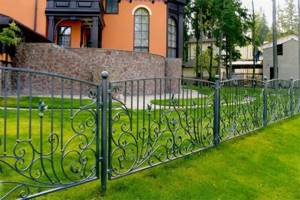
After agreeing on the sketch, production material and other important details, the manufacturing of the structure begins. It is produced in one of three ways:
- Manual, when all elements of artistic forging are produced by hand
- Machine-based, when individual parts of the ornaments are made on special machines
- Combined, when forging elements are produced both manually and by machine
Regardless of how the decorative elements are made, they are attached to the frame by welding. The resulting seams are processed to hide irregularities. Then the wrought iron fence is coated with a special protective compound or paint with protective properties - it should prevent the appearance of rust. Most often they are painted in one color, but two-color painting can also be used. For example, the Teofilo wrought iron fence has a good contrast between gold and black.
Beautiful patterns on fences
A fence is not only an enclosing structure designed to protect a site from prying eyes and unwanted intrusions. It is also a decoration for your home. What it will be depends only on you. And it doesn’t matter whether you create beauty with your own hands or entrust it to specialists.
Forged fence elements always look stylish and beautiful
You can fence your property with any fence: metal, wood, stone, but it does not have to look like a fortress wall. A little imagination, and even a concrete fence or a chain-link mesh stretched between posts can become a real art object, a decorative decoration for your home.
Ready-made fence decorations
Today, many companies engaged in the manufacture and installation of fences, gates, railings and other enclosing structures offer their clients various options for decorating them. Let's look at some of them.
Forged Products
In the first photo you already saw an openwork wrought iron fence. Its design can be anything - from floral to strict ornamental, with sharp peaks along the upper edge. But not all homeowners are ready to be so open to prying eyes, and besides, the price of wrought-iron fences is quite high.
Therefore, you can use for decoration only individual forged elements made of metal rods and attached to the front surface or along the perimeter of the fence.
Metal patterns for a brick fence
Advice. Forged metal products will not lose their attractiveness and will last a very long time if their coating is renewed every few years.
Metal jewelry
Thanks to the advent of plasma cutting technology for sheet metal, today we have the opportunity to order any, even the most complex patterns for different types of fences.
- Overlay elements that are attached to the plane of the fence,
- Fence strips mounted along the upper or lower edge,
Patterns for a fence made of corrugated sheets are cut into a rectangular metal strip
- Mortise openwork inserts into a solid fence, etc.
These decorative elements are coated with a special polymer composition of different shades, which protects the metal from atmospheric influences, does not fade in the sun, and does not crack from high or very low temperatures.
A new product on our market is fences made of metal sheets with a laser-cut pattern.
The drawing is made by laser cutting
Wooden decorations
Wooden fences are regaining popularity after a short period of oblivion. Now they have become more durable, as they are made from elements that have undergone special treatment against rotting and insect pests, and are impregnated with compounds that protect them from fire.
Manufacturers of such fences, in addition to structural elements - supports, picket fences, etc., also make patterns for wooden fences, which are carved parts.
Wooden fence decorated with carved details
In addition, you can create a beautiful and unusual pattern from the pickets themselves of different heights, widths or shapes, securing them in a certain sequence, painting each one in its own color.
Several triangular cutouts along the edges of the picket fence give such an interesting pattern.
Advice. You can also use the metal fence patterns mentioned above to decorate a wooden fence with them.
DIY decoration
Not everyone and not always have the opportunity to replace an old fence with a new one, but anyone can make it more beautiful, no matter what it is made of.
Here are just a few examples that will help you decide or give you ideas of your own.
- If you are good at drawing, use your skill. The design can be applied to any surface using special facade paints that are resistant to moisture, sunlight, and temperature. If you don’t know how to draw, use stencils or just make your fence multi-colored and striped.
Anyone can do this drawing.
- Another interesting way to decorate is mosaic. It can be made from anything: shells, pebbles, broken tiles and mirrors, and even from plastic bottle caps. To create a pattern from the latter, you don’t even need instructions. Simply screw the lids on with self-tapping screws or nails in a pre-designed order, alternating by color.
Broken tile mosaic
- If you cut off the bottom from the same plastic bottle and paint it, you will get a cute flower, and you can cut stems and leaves from the walls. Several such blanks, and you can “weave” any floral patterns on the fence.
Flowers from plastic bottles
- A chain-link fence can become a real canvas for “embroidery.” Only you need to embroider patterns not with threads, but with thin wire, electrical wires in a multi-colored braid, or even colored plastic bags. See how original it can look.
Floral motif from bags
Conclusion
You can come up with a lot more ways to decorate fences so that they please the eye at any time of the year, and not just in the summer, when flowering plants climb over them. Of course, iron fences with laser-cut patterns look simply luxurious, but they are also very expensive.
But don’t be upset if you can’t install one near your home. You can create beauty on your own, and almost for nothing (
Wrought iron fence styles
Forged fences, like any other metal structures, have their own styles. The most common of them are:
- Modern . It is characterized by “bio-similar” shapes, expressive silhouettes and a large amount of decor. There are practically no straight lines or strict angles - the main part of the decor is smooth, soft, close to natural silhouettes.
- Empire style . Unlike modernism, it is characterized by rigor, clarity, straight lines and regular geometric shapes. Strict lines are complemented by decorative patterns - smooth lines, circles, plant elements. The result is an attractive combination of severity and softness.
- Classicism . Its main features are sculpturality, repeating symmetry and restrained simplicity. The compositions look complete, durable, and attractive.
- Baroque . The most important characteristic feature is the intricacy of the forms. This style uses elaborate lines, unusual decor, complex curls and other decorative elements.
- Art Deco . It is characterized by a unique combination of futurism - forms as if they came from the future - and restrained simplicity. In some ways, Art Deco is similar to Upworld, because its severity is also complemented by unusual shapes, decorations, and ornaments.
- Gothic . The style is characterized by upward direction of the ornament, symmetry and strict geometrically correct forms. It often uses peaks and other pointed decorative elements.
- Rococo . The design of a wrought iron fence is dominated by “flying” elements that look elegant and weightless. There is no symmetry, but many smooth lines are woven into a single composition.
- Renaissance . It uses completed compositions that look weightless and elegant. Much attention is paid to cast elements and standard decor - for example, braids or figures of eight.
- Roman style . It is characterized by solid, massive, seemingly heavy details. At the same time, large forms are not without grace - for example, spiral-shaped elements predominate in most of the ornament.
The choice of style depends entirely on your personal preferences. In any case, a wrought iron fence will look stylish, unusual and attractive.
Often a combination of several styles is used in designs, especially when making complex compositional paintings. For example, the wrought-iron fence for the “Aria” brick fence uses a strict frame, a massive cast element and elegant decor. And in the Hatikora model, most of the links are made in the Romanesque style, and the last link is more Empire style.
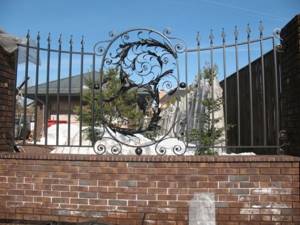
How to make a beautiful wrought iron fence: photos of designs
Today, the variety of forged elements is so wide that anyone can face the problem of choosing a suitable pattern. In addition, you need to make the right choice of color design for the fence. The classic option is a black fence, decorated with gold-colored curly elements. Such a fence looks strict and presentable. Various dark shades of colors are also popular.

The use of forged fence sections and a stone base is a very popular fencing option.
Note! If necessary, additional procedures can be carried out (for example, patination). This will give the fence the appearance of antique metal. Photos of beautiful wrought iron fences and gates with patination allow you to see the attractiveness of this solution.
As for additional materials, there are also some nuances that are worth paying attention to. To install a forged blind fence, corrugated sheets, polycarbonate, wood or metal sheets can be used.

The fence should fit harmoniously into the overall design of the site
Polycarbonate is ideal when the area is made in a modern design. Corrugated sheeting is a universal material. A fence made of corrugated board and forging looks presentable, is reliable and has a good degree of protection. Wood and metal are best used to create beautiful designs.
Choosing a fence design requires taking into account other important factors. The type of terrain plays a big role. The fence should fit the specific landscape and look natural in it. The choice of the required shade should be made taking into account the color of the roof of a residential building.

Decorative elements with gilding add solemnity to the forged fence
Sketch of a wrought iron fence: choosing the appropriate style
A wrought iron fence is the most spectacular fence known. However, it is much more difficult to install than any other design. The design of this product includes the development of a sketch. For this purpose, it is worth determining in advance the style in which the metal fence will be made. Let's consider the possible options:
- Russian;
- Russian-Byzantine;
- Gothic;
- baroque;
- rococo;
- modern
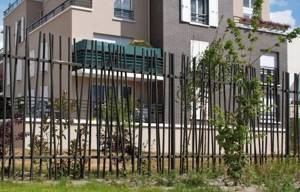
Modern forged fences are easy to make and operate
Russian. This style takes into account the use of forged products that have a convex design. The pattern can be different, but most often it has natural motifs.
Russian-Byzantine. Just like Russian, it contains a large number of convex elements. They can imitate natural patterns, but the difference in this case is that the composition is complemented by geometric shapes. This style is very popular. Before choosing the right direction, it is recommended to study photos of forged fences and gates. The sketch picture must be made as competently as possible, respecting proportions and shapes.
Gothic. Fences made in this direction look very impressive. The style itself has several distinctive features. The main one is an elongated structure, rushing to the sky. An often used element in this case is the pointed arch.
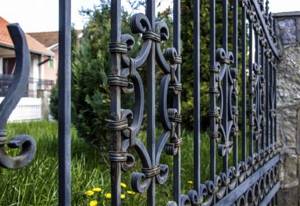
Creating forged decorative elements for a fence requires skill and skill.
Helpful information! If necessary, you can download a finished sketch from the Internet. This will save time and effort.
Baroque. This direction is oversaturated with luxury motifs. This type of fence includes a large number of small shaped elements. These can be various ornate products, flowers and baskets.
Rococo. This direction is considered a continuation of the Baroque style. The difference in this case is that this style contains fewer elements. The emphasis is on elegance. Modern. Fences in this style include abstract elements. It is worth noting that curved lines, evenly spaced (or not) on the fence, are popular.

The combination of white pillars and forged sections looks stylish
Understanding the styles, it is much easier to choose the desired direction and develop a sketch of a wrought iron fence. Photos of structures made in different directions allow you to clearly see the advantages of a particular flow.
Choosing a wrought iron fence design for your home
Modern technologies make it possible to produce forged structures of any shape. However, from the whole variety of fencing models, there are several that are traditional. They are most often purchased to organize the protection of private and country houses.
The design features of this structure must first of all have all the necessary functional qualities. The appearance of the fence does not play such an important role. This rule allows us to identify several dominant structures.
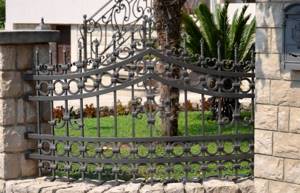
Installing a forged fence will require some effort, but the result is worth it
The first popular solution is to install a fence consisting of separate sections (spans). Between them are brick support pillars. This design can be installed on a low parapet (up to 1 m). Brick pillars look very presentable, which is why they are often preferred to standard wrought-iron pillars.
The second common structure is a solid metal fence. This design consists of a single piece of fabric, which is fixed on round posts made of steel. Such supports have a high strength coefficient, which helps to increase the service life of the fence.

To protect against rust and environmental influences, be sure to paint the forged fence
The last common option is forged construction with shielding. The combination of forging and corrugated sheeting is the most popular solution. Polycarbonate or ordinary metal sheets with thin walls can also be used for these purposes.
How to choose a wrought iron fence
When choosing a sketch, pay attention to the landscape design. The design of the fence should be consistent with the surroundings. For example, a fence with Roheya corrugated sheets, painted to resemble a stone fence, is perfect for a country cottage with a stone facade. To understand whether a forged fence will look good on the site, you can ask the craftsman to make a small ornament, or substitute an image of the structure on a photo of the site in a graphics editor.

Pay attention to the appearance of the fence. Here are a few nuances that deserve special attention:
Quality of welds . They are usually located at the junction of decorative elements with the frame - a metal base. In a normal design, the seams are practically invisible, do not “float” onto the metal and have a smooth surface. If the seams are crooked, rise strongly above the metal surface or have holes, it is better to refuse the purchase - the strength of the structure is automatically called into question.
Presence of sharp elements . They can injure you or your child - for example, if he crashes into a fence while riding his bike. Therefore, it is better to choose designs with soft decorative elements without sharp corners, or clean the sharp parts yourself.
Distance between elements . The optimal distance between the rods is 10 centimeters. It is provided so that in welded structures, intruders will not be able to enter the site, and in other structures, so that children and animals cannot get stuck in the wrought-iron fence.
Height . The standard height of the structure is about 2 meters. If you purchase a lower fence, strangers can look into the yard through it. If you want to reliably protect yourself from intruders, pay attention to models with a height of more than 3 meters.
Type of wrought iron fence . If the views of strangers do not bother you, and the area is large enough, you can install a welded structure. If you want to protect yourself from glare, but don't want to lose sunlight, choose models with polycarbonate. A wrought-iron fence with an iron sheet or corrugated sheet will provide the most reliable protection from curious passers-by.
Presence of a protective layer . The fence is located in the open air, so it will often be exposed to precipitation. Moisture can cause corrosion - rust. It significantly reduces the technical characteristics of the metal and spoils its appearance. Therefore, it is better to choose models coated with protective compounds - they tolerate snow and rain, and high air humidity well.
How to install wrought iron gates
Installation of forged gates takes place in several stages. First, measure the length of one section of the fence to mark the area, and mark the location of future support posts. They are included in the structure or installed separately, and the sections are then simply attached to poles.
In the places where the support pillars are installed, they dig a hole 20-30 centimeters deep and about 15-20 centimeters in diameter. Pillars are installed in them, leveled and then concreted. It is advisable to hang the sections when the solution has already hardened - the next day, in order to avoid distortion of one of the sides of the fence.
